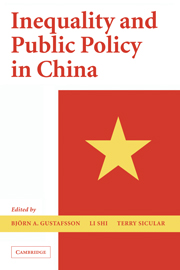Book contents
- Frontmatter
- Contents
- List of Tables and Figures
- Contributors
- Acknowledgments
- 1 Inequality and Public Policy in China: Issues and Trends
- 2 Income Inequality and Spatial Differences in China, 1988, 1995, and 2002
- 3 Growth and Distribution of Household Income in China between 1995 and 2002
- 4 Explaining Incomes and Inequality in China
- 5 The Distribution of Wealth in China
- 6 Growth, Inequality, and Poverty: A Comparative Study of China's Experience in the Periods before and after the Asian Crisis
- 7 What Has Economic Transition Meant for the Well-Being of the Elderly in China?
- 8 Inequity in Financing China's Health Care
- 9 China's Emerging Urban Wage Structure, 1995–2002
- 10 Unemployment, Earlier Retirement, and Changes in the Gender Income Gap in Urban China, 1995–2002
- 11 What Determines Living Arrangements of the Elderly in Urban China?
- 12 The Impact of Village-Specific Factors on Household Income in Rural China
- 13 The Redistributive Impact of Taxation in Rural China, 1995–2002: An Evaluation of Rural Taxation Reform at the Turn of the Century
- Appendix: The 1995 and 2002 Household Surveys: Sampling Methods and Data Description
- Index
- References
8 - Inequity in Financing China's Health Care
Published online by Cambridge University Press: 25 July 2009
- Frontmatter
- Contents
- List of Tables and Figures
- Contributors
- Acknowledgments
- 1 Inequality and Public Policy in China: Issues and Trends
- 2 Income Inequality and Spatial Differences in China, 1988, 1995, and 2002
- 3 Growth and Distribution of Household Income in China between 1995 and 2002
- 4 Explaining Incomes and Inequality in China
- 5 The Distribution of Wealth in China
- 6 Growth, Inequality, and Poverty: A Comparative Study of China's Experience in the Periods before and after the Asian Crisis
- 7 What Has Economic Transition Meant for the Well-Being of the Elderly in China?
- 8 Inequity in Financing China's Health Care
- 9 China's Emerging Urban Wage Structure, 1995–2002
- 10 Unemployment, Earlier Retirement, and Changes in the Gender Income Gap in Urban China, 1995–2002
- 11 What Determines Living Arrangements of the Elderly in Urban China?
- 12 The Impact of Village-Specific Factors on Household Income in Rural China
- 13 The Redistributive Impact of Taxation in Rural China, 1995–2002: An Evaluation of Rural Taxation Reform at the Turn of the Century
- Appendix: The 1995 and 2002 Household Surveys: Sampling Methods and Data Description
- Index
- References
Summary
Introduction
The health status of the population is of central importance to any country. At the beginning of the new millennium, China had a relatively healthy population. Life expectancy at birth in 2002 was 71 years, exceeding the world average by four years (World Bank 2006). This represents great improvement for a country that experienced a disastrous famine resulting in high mortality in the late 1950s. China's recent health record, however, is not just due to the performance of the health sector but is an outcome of China's favorable economic development. With decreasing proportions of the rural population living in extreme poverty, levels of nutrition and general health have improved.
A country's health care system can be assessed from different perspectives. Economic analyses typically examine levels of efficiency and costs as well as access to the services provided and how the sector is financed. This last issue, the financing of health services, is the focus of this chapter. According to recent reports, the performance of the Chinese health sector in terms of how it is financed has been very poor indeed. When the World Health Organization (2000) in its World Health Report ranked health care systems in 191 countries according to fairness in financial contributions, China ranked near the bottom at 188 (WHO 2000).
Currently a large body of literature addresses questions on inequity in health care funding around the world. Methods of study have been developed, some making use of advances in the literature on income distribution and taxation.
- Type
- Chapter
- Information
- Inequality and Public Policy in China , pp. 204 - 220Publisher: Cambridge University PressPrint publication year: 2008
References
- 2
- Cited by



